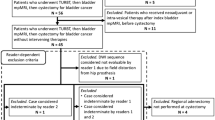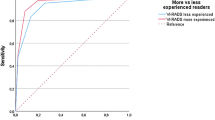Abstract
Objective
We evaluated the correlation of radiological findings obtained by MRI study with pathological diagnosis in invasive bladder cancer treated with neoadjuvant chemotherapy, with or without radiation.
Design, Setting, and Participants
Twenty-seven patients, who underwent total or partial cystectomy for invasive bladder tumors, were enrolled into the present study. Eight cases had received neoadjuvant chemotherapy following the staging biopsy (group A), ten cases had received chemo-radiation therapy following the staging biopsy (group B), and nine cases had received preoperative staging biopsy alone (group C). As a final treatment, 12 of the 27 patients underwent total cystectomy and the other 15 patients underwent partial cystectomy. MRI was conducted prior to total or partial cystectomy in each case. The pathological stage was assessed by histological examination of the entire layer of the bladder wall.
Results and Limitations
Tumor stage assessed by MRI was consistent with pathological findings in 16 of the 27 cases (59.3%), while MRI produced over-staging in 7 cases and under-staging in 4 cases. The accuracy of staging was 75.0, 30.0, and 77.8% in groups A, B, and C, respectively. The accuracy of MRI staging in group B was lower than that in group C (P < 0.05). There was no difference in the accuracy of MRI staging between groups A and C.
Conclusion
MRI is useful for the staging of bladder cancer. However, care needs to be taken when staging invasive bladder tumors treated with neoadjuvant chemo-radiation therapy, because inflammatory infiltrations and/or fibrous changes caused by the chemotherapy or chemo-radiation therapy make precise staging with MRI difficult.


Similar content being viewed by others
References
Tachibana M, Baba S, Deguchi N et al (1991) Efficiency of gadolinium diethylene triamine pentaacetic acid-enhanced magnetic response imaging for differentiation between superficial and muscle-invasive tumor of the bladder. J Urol 145:1169–1173
Tanimoto A, Yuasa Y, Imai M et al (1992) Bladder tumor staging: comparison of conventional and gadolinium-enhanced dynamic MRI and CT. Radiology 185:741–747
Narumi Y, Kadota T, Inoue E et al (1993) Bladder tumors: staging with gadolinium-enhanced oblique MRI. Radiology 187:145–150
Takes A, Kamel I, Imam K et al (2005) Dynamic MRI of bladder cancer: evaluation of staging accuracy. AJR Am J Roentgenol 184:121–127
Grossman HB, Natale RB, Tangen CM et al (2003) Neoadjuvant chemotherapy plus cystectomy compared with cystectomy alone for locally advanced bladder cancer. N Engl J Med 349:859–866. doi:10.1056/NEJMoa022148
Macvicar AD (2000) Bladder cancer staging. BJU Int 86:111–122. doi:10.1046/j.1464-410X.2000.00589.x
Kim B, Semelka R, Ascher S et al (1994) Bladder tumor staging: comparison of contrast-enhanced CT, T1- and T2-weighted MRI, dynamic gadolinium-enhanced imaging, and late gadolinium-enhanced imaging. Radiology 193:239–245
Barentsz JO, Jager GJ, van Vierzen PB et al (1996) Staging urinary bladder cancer after transurethral biopsy: value of fast dynamic contrast-enhanced MRI. Radiology 201:1851–1893
Sugimura K, Carrington B, Quivey J et al (1990) Postirradiation changes in the pelvis: assessment with MRI. Radiology 175:805–813
Barentsz JO, Berger-Hartog O, Witjes J et al (1998) Evaluation of chemotherapy in advanced urinary bladder cancer with fast dynamic contrast-enhanced MRI. Radiology 207:791–797
Schrier BP, Peters M, Barentsz JO et al (2007) Evaluation of chemotherapy with magnetic response imaging in patients with regionally metastatic or unresectable bladder cancer. Eur Urol 49:698–703. doi:10.1016/j.eururo.2006.01.022
Narumi Y, Kadota T, Inoue E et al (1993) Bladder wall morphology: in vitro MR imaging—histopathologic correlation. Radiology 187:151–155
Author information
Authors and Affiliations
Corresponding author
Rights and permissions
About this article
Cite this article
Nishimura, K., Fujiyama, C., Nakashima, K. et al. The effects of neoadjuvant chemotherapy and chemo-radiation therapy on MRI staging in invasive bladder cancer: comparative study based on the pathological examination of whole layer bladder wall. Int Urol Nephrol 41, 869–875 (2009). https://doi.org/10.1007/s11255-009-9566-5
Received:
Accepted:
Published:
Issue Date:
DOI: https://doi.org/10.1007/s11255-009-9566-5




